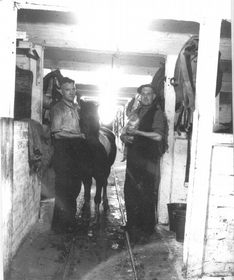Pit ponies were stabled underground because it was hard work to bring them to the surface. In deep mines they became used to warm and equable temperatures and with the variable climate of the surface their health could suffer. They would only come to the surface for the annual holiday or during long strikes or lockouts.
At some pits they were taken underground in the cage like the men, but at many they had to be individually suspended beneath the cage in a sling or net. This is what happened at Caphouse Colliery. They were so frightened that they usually kept completely still after an initial struggle. It must have been a terrifying experience, and was the main reason why the ponies were not brought to the surface at the end of each shift.
In their underground stables, the ponies were out of the way of the main roads and in the intake airway, so that they could breath the same fresh air from the surface as the men. The stables were lit mainly by electricity, had concrete floors and brick walls and the natural roof of the mine was usually supported by steel girders.
At some pits they were taken underground in the cage like the men, but at many they had to be individually suspended beneath the cage in a sling or net. This is what happened at Caphouse Colliery. They were so frightened that they usually kept completely still after an initial struggle. It must have been a terrifying experience, and was the main reason why the ponies were not brought to the surface at the end of each shift.
In their underground stables, the ponies were out of the way of the main roads and in the intake airway, so that they could breath the same fresh air from the surface as the men. The stables were lit mainly by electricity, had concrete floors and brick walls and the natural roof of the mine was usually supported by steel girders.


